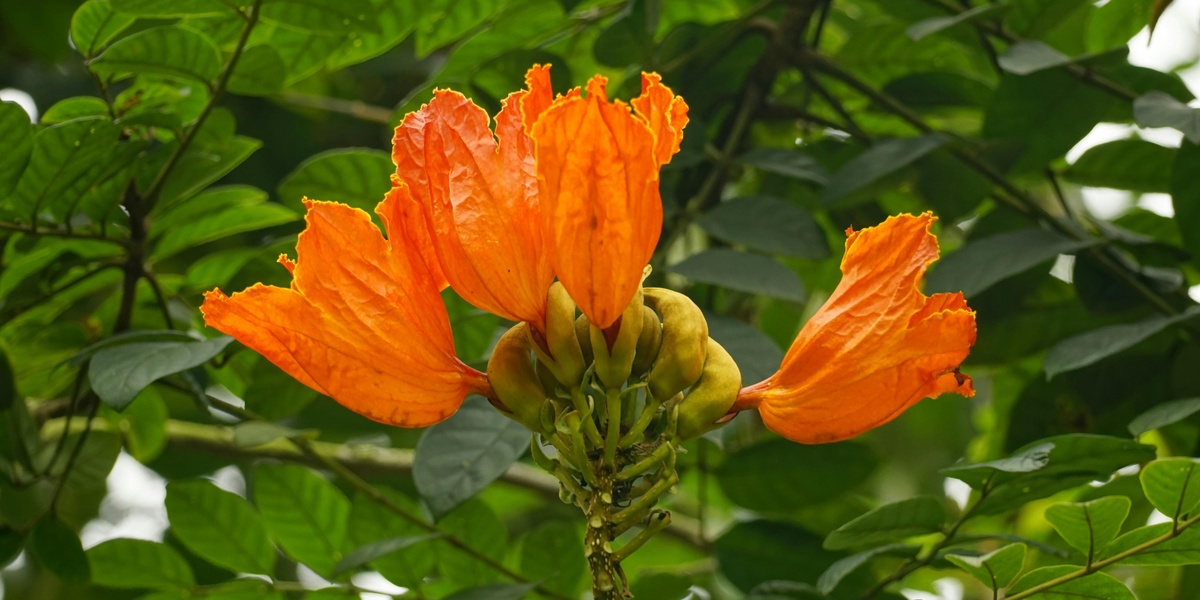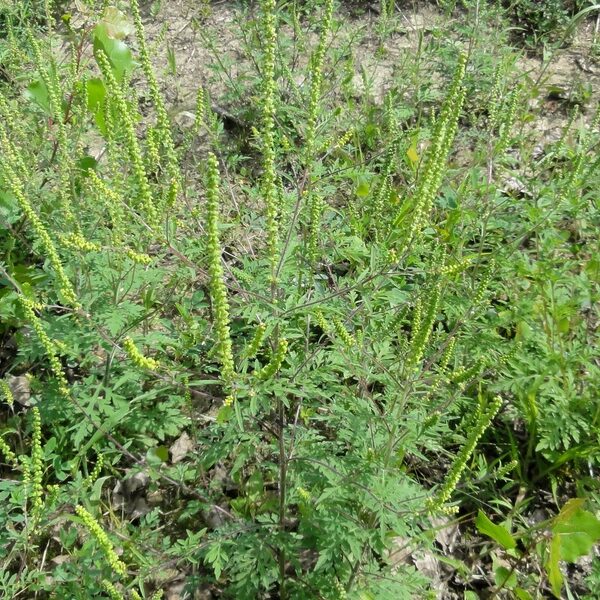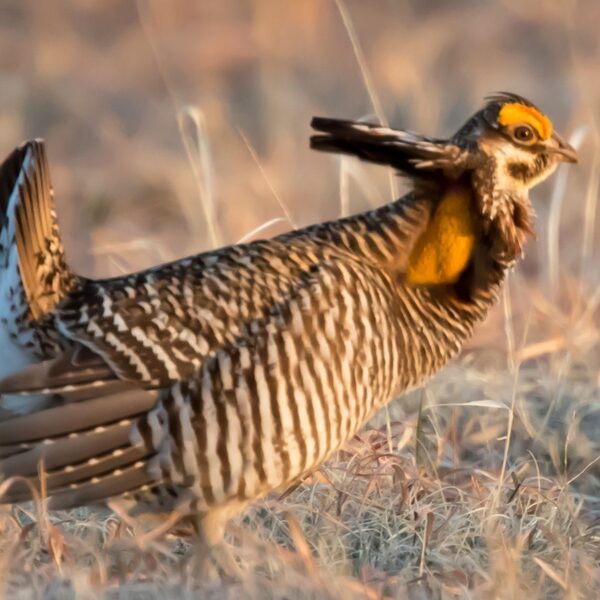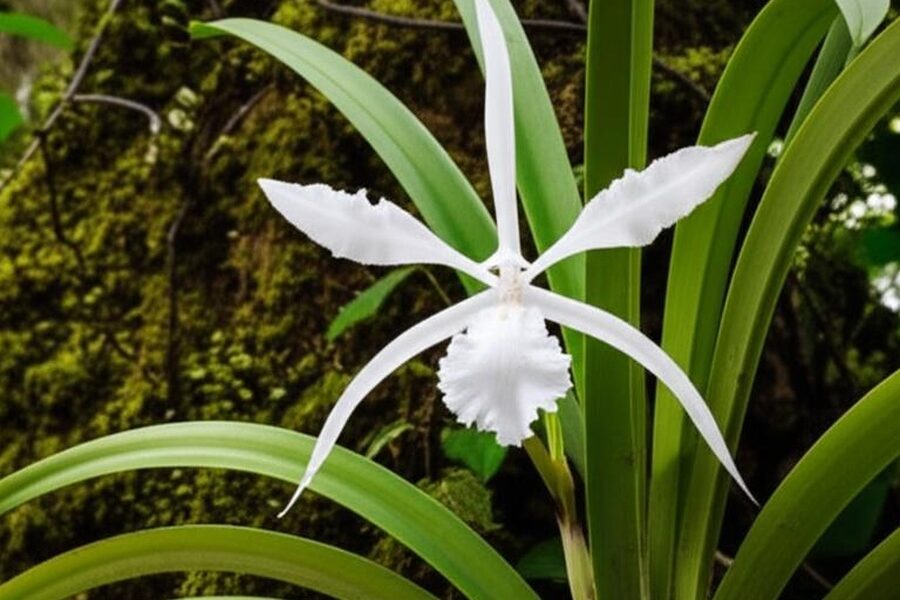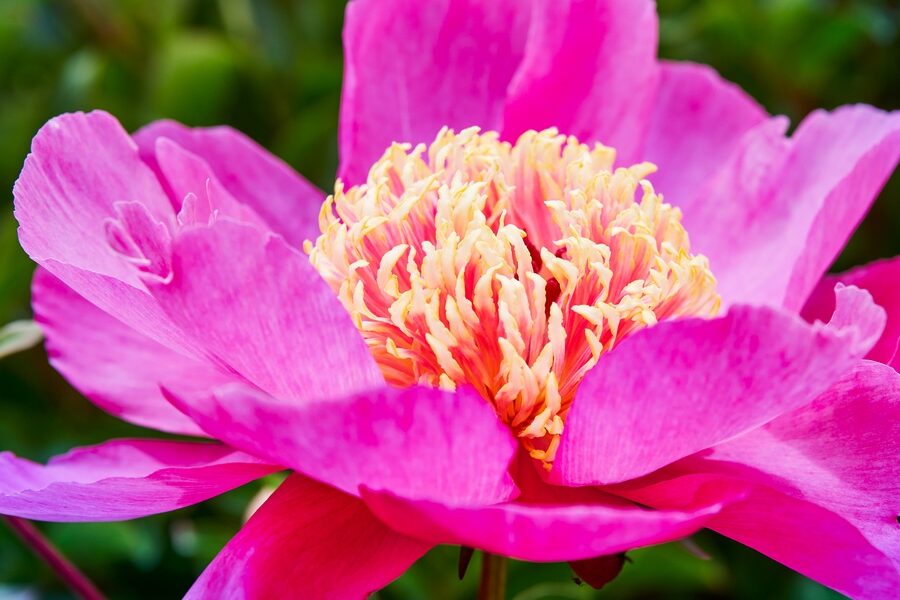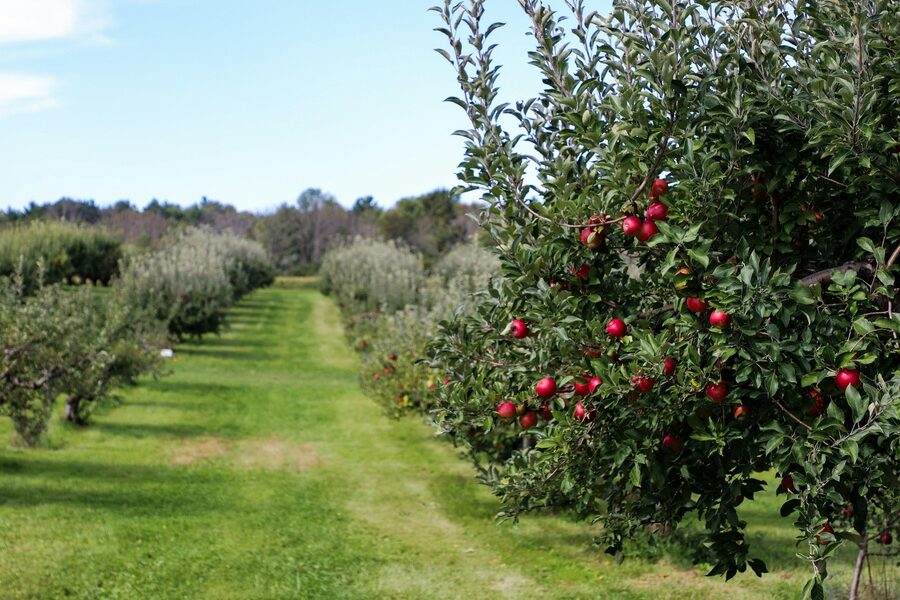Botswana’s landscapes—from the arid Kalahari to seasonal floodplains—support a wide range of plant life that marks the changing seasons and local habitats. Many species are tied to specific soils and rainfall patterns, so a short drive can take you through very different floral communities.
There are 40 Flowers of Botswana, ranging from African Mangosteen to Woolly Caper-bush. For each entry I list Scientific name, Habitat/region, Bloom season (months) so you can compare where and when each plant appears; you’ll find those details below.
When is the best time to see wildflowers across Botswana?
The prime viewing times depend on region: after the summer rains (late spring to early autumn) brings the richest displays in most areas, while some pans and riverine zones flower slightly later; check the Bloom season (months) column for species-specific timing.
Are any species on the list rare or legally protected?
Yes—some entries are locally uncommon or protected due to limited ranges or habitat loss; consult local conservation listings and the Habitat/region column before collecting or disturbing plants, and consider guided visits to sensitive sites.
Flowers of Botswana
| Common name | Scientific name | Habitat/region | Bloom season (months) |
|---|---|---|---|
| Flame Lily | Gloriosa superba | Widespread in woodlands, grasslands, and sandy soils; Okavango, Chobe. | Dec–Mar |
| Baobab | Adansonia digitata | Hot, dry woodland on sandy soils; Makgadikgadi Pans, northern Botswana. | Oct–Dec |
| Sausage Tree | Kigelia africana | Riverine forests and floodplains; abundant in Okavango Delta and along Chobe River. | Aug–Nov |
| Camel Thorn | Vachellia erioloba | Deep Kalahari sands and dry riverbeds throughout Botswana. | Jul–Sep |
| Devil’s Claw | Harpagophytum procumbens | Kalahari sands, open grasslands, and disturbed areas. | Dec–Apr |
| Blue Water Lily | Nymphaea nouchali var. caerulea | Permanent water bodies; Okavango Delta, Chobe River, and larger pans. | All year |
| Kalahari Christmas Tree | Dichrostachys cinerea | Widespread in savanna, bushveld, and disturbed areas. | Oct–Feb |
| Trumpet Thorn | Catophractes alexandri | Dry, rocky areas and calcareous soils; Kalahari regions. | Sep–Nov |
| Wild Dagga | Leonotis nepetifolia | Disturbed areas, roadsides, and riverbanks across the country. | Mar–Jun |
| Purple-pod Terminalia | Terminalia prunioides | Dry bushveld and savanna, often on Kalahari margins. | Oct–Dec |
| African Mangosteen | Garcinia livingstonei | Riverine forest and on termite mounds; Okavango, Chobe, and Linyanti regions. | Oct–Dec |
| Wild Foxglove | Ceratotheca triloba | Disturbed ground, old farmlands, and roadsides. | Dec–Apr |
| Mopane | Colophospermum mopane | Dominant in hot, low-lying areas, forming Mopane woodland; northern Botswana. | Dec–Jan |
| Poison Apple | Solanum incanum | Widespread in overgrazed or disturbed areas. | All year |
| African Wattle | Peltophorum africanum | Widespread in savanna and woodland throughout Botswana. | Oct–Jan |
| Buffalo Thorn | Ziziphus mucronata | Widespread in various habitats, from riverbanks to dry savanna. | Nov–Feb |
| Wild Gardenia | Gardenia volkensii | Dry woodland, bushveld, and on rocky outcrops. | Aug–Nov |
| Common Coral Tree | Erythrina lysistemon | Wooded grasslands and bushveld, mainly in eastern Botswana. | Jul–Sep |
| Tumbleweed | Boophane disticha | Dry grasslands and savanna, often in sandy soils. | Sep–Nov |
| Woolly Caper-bush | Capparis tomentosa | Savanna, riverine thickets, and on termite mounds. | Aug–Nov |
| Kalahari Bauhinia | Bauhinia petersiana | Sandy soils and woodland, especially in northern and western Botswana. | Nov–Mar |
| Leopard Orchid | Ansellia africana | Epiphytic on large trees in riverine forests; Okavango Delta, Chobe. | Jul–Oct |
| Swamp Crinum | Crinum macowanii | Seasonal pans, floodplains, and damp grasslands. | Nov–Jan |
| Devil’s Thorn | Tribulus zeyheri | Widespread in disturbed, sandy areas and roadsides. | Sep–May |
| Fever Tea | Lippia javanica | Widespread in savanna, grasslands, and disturbed areas. | All year |
| Bitter Aloe | Aloe marlothii | Rocky hillsides and slopes, mainly in eastern Botswana. | May–Aug |
| Ground-lily | Ammocharis coranica | Sandy grasslands and open plains, often flowering after fire. | Oct–Dec |
| Sandpaper Raisin | Grewia flava | Widespread and common in Kalahari sandveld and dry bush. | Oct–Feb |
| Pink Jacaranda | Stereospermum kunthianum | Woodland and rocky areas in northern Botswana, especially Chobe. | Aug–Oct |
| Hoodia | Hoodia gordonii | Arid, rocky parts of the Kalahari desert. | Sep–Oct |
| Tsamma Melon | Citrullus lanatus | Kalahari sands, open plains, and disturbed areas. | Jan–Apr |
| Large-flowered Worm-bush | Cadaba aphylla | Arid savanna and scrubland, common in the Kalahari. | Jul–Sep |
| Wild Hibiscus | Hibiscus cannabinus | Wetlands, riverbanks, and other damp, grassy areas. | Feb–May |
| Okavango Cat’s Whiskers | Clerodendrum uncinatum | Okavango Delta floodplains and riverine forest margins. | Nov–Feb |
| Sand Camwood | Baphia massaiensis | Kalahari sands, woodland, and bushveld. | Sep–Nov |
| Russet Bushwillow | Combretum hereroense | Savanna, woodland, and along riverbanks. | Aug–Nov |
| Common Star-chestnut | Sterculia rogersii | Rocky outcrops and dry, wooded hillsides in eastern Botswana. | Sep–Oct |
| Wild Scabious | Scabiosa columbaria | Grasslands and open woodland, often in montane areas. | Sep–Mar |
| Paperbark Thorn | Vachellia sieberiana | Woodland and riverine fringes, often in higher rainfall areas. | Sep–Nov |
| Gemsbok Cucumber | Acanthosicyos naudinianus | Widespread on Kalahari sands and in disturbed areas. | Dec–Apr |
Images and Descriptions
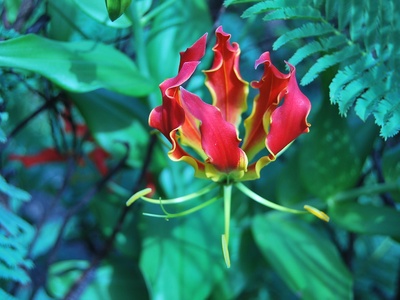
Flame Lily
Botswana’s national flower. This spectacular climbing lily has wavy-edged, bicolored petals of brilliant red and yellow. All parts of the plant are highly poisonous but it is a truly iconic sight when in bloom.
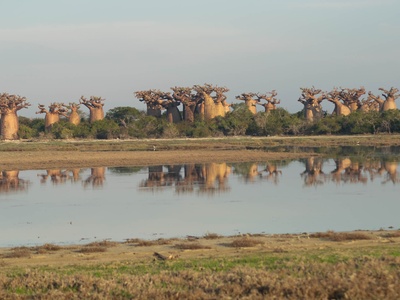
Baobab
Known as the “upside-down tree,” this iconic giant produces huge, waxy, white flowers that hang downwards. They open at night and are pollinated by bats, lasting for only 24 hours before turning brown.
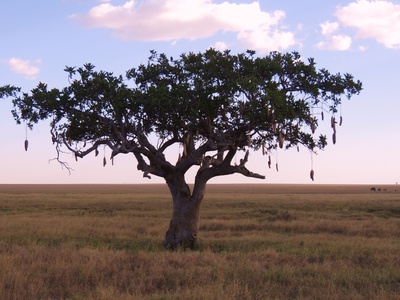
Sausage Tree
A large, spreading tree famous for its long, sausage-shaped fruits. It produces large, velvety, blood-red, trumpet-shaped flowers that hang on long stems and open at night to attract bat pollinators.
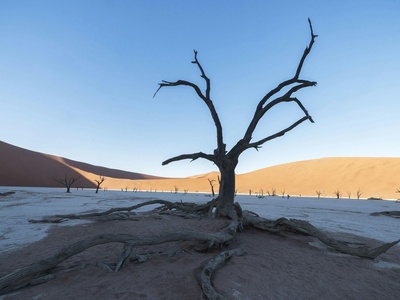
Camel Thorn
An iconic, slow-growing tree of the Kalahari, providing vital shade and food. It produces fragrant, bright yellow, fluffy ball-like flowers that are a magnet for insects, followed by distinctive, velvety, ear-shaped pods.
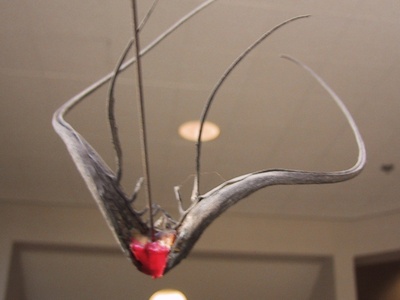
Devil’s Claw
A ground-creeping perennial herb with succulent leaves. It is famed for its large, trumpet-shaped, mauve to purple flowers and its woody fruit covered in grappling hooks. The tuber is used in traditional medicine.
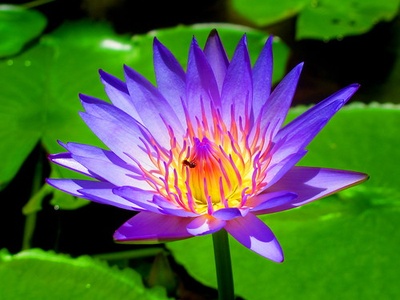
Blue Water Lily
An iconic aquatic plant of the Okavango. Its beautiful, star-shaped blue or white flowers open in the morning and close in the afternoon, floating gracefully on the water’s surface among round lily pads.
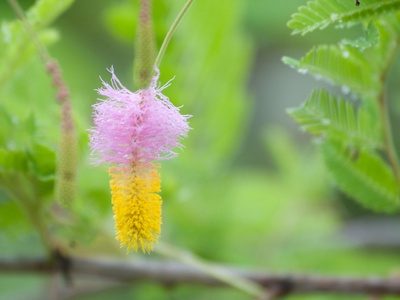
Kalahari Christmas Tree
Also known as Sickle Bush, this thorny shrub is easily identified by its unique, bicolored flower spikes. The top half is sterile and pink or lilac, while the bottom half is fertile and yellow.
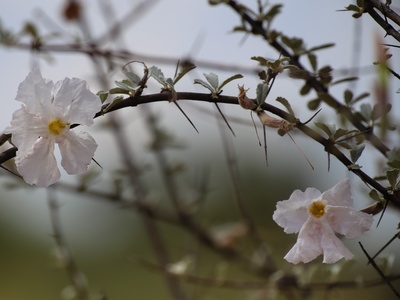
Trumpet Thorn
A rigid, spiny shrub that bursts into life after the first rains. It becomes covered in masses of large, fragrant, and spectacular white to pale pink trumpet-shaped flowers, attracting hawk moths at dusk.
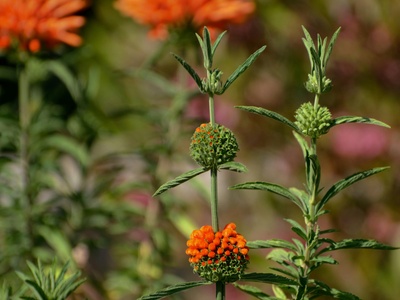
Wild Dagga
A tall, erect annual herb with square stems. It produces distinctive whorls of bright orange, fuzzy, tubular flowers arranged in layered clusters up the stem, which are rich in nectar and attract sunbirds.
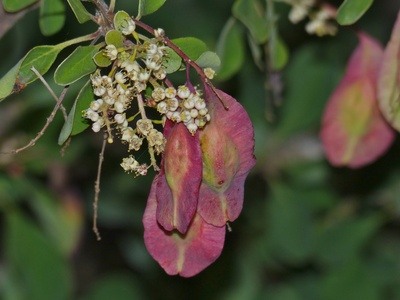
Purple-pod Terminalia
A common shrub or small tree, easily recognized by its distinctive fruit. It produces spikes of small, creamy-white, honey-scented flowers that attract bees, later forming beautiful, two-winged, papery pods that turn a deep purple-red.
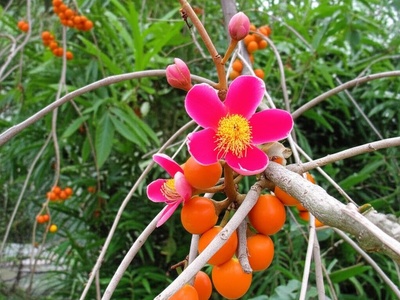
African Mangosteen
A medium-sized evergreen tree with a dense, rounded crown. It produces unusual, attractive pinkish-red flowers with yellow stamens directly on the woody branches, followed by edible, orange-red, fleshy fruits.
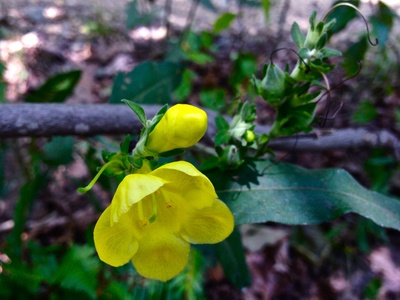
Wild Foxglove
A fast-growing annual herb that can reach up to 2 meters. It bears large, attractive, bell-shaped flowers that are typically mauve or pale pink with darker purple lines inside, resembling a cultivated foxglove.
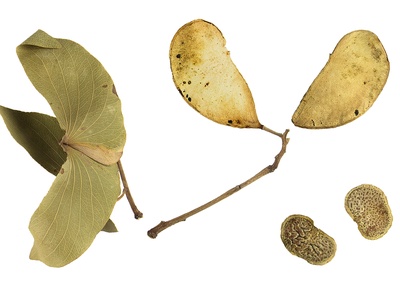
Mopane
One of Botswana’s most important trees, forming vast woodlands. Its leaves are butterfly-shaped, and it produces clusters of small, inconspicuous, greenish-yellow flowers that lack petals and are wind-pollinated.
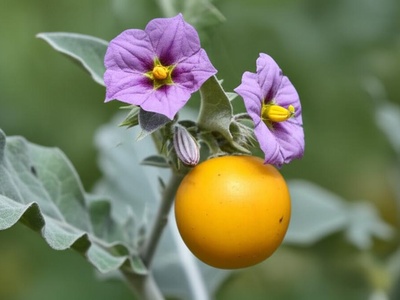
Poison Apple
A common, spiny shrublet with soft, grey-green, felt-like leaves. It produces pretty, star-shaped purple flowers with a prominent yellow center, which are followed by large, smooth, yellow fruits that are highly toxic.
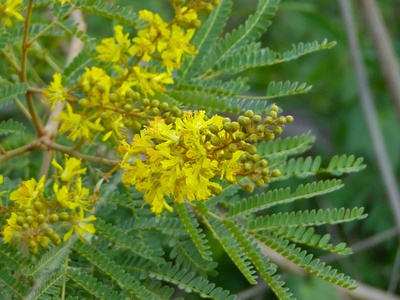
African Wattle
A graceful, deciduous tree with feathery, acacia-like leaves. It puts on a spectacular display when it produces large, upright spikes of crinkled, bright yellow flowers, making it a standout in the bushveld.
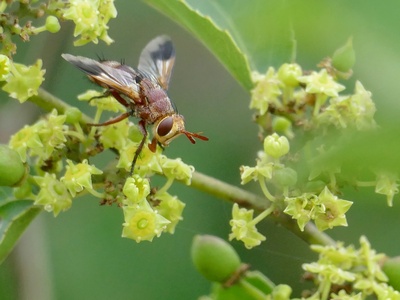
Buffalo Thorn
A small to medium-sized tree with distinctive paired thorns—one hooked, one straight. Its flowers are small, inconspicuous, greenish-yellow, and star-shaped, but produce a sweet scent that is irresistible to insects.
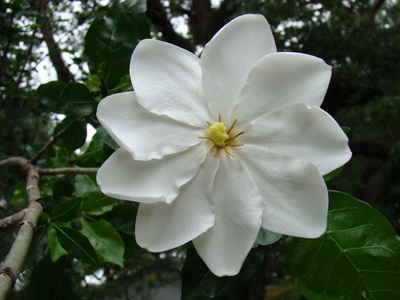
Wild Gardenia
A small, rigid, multi-branched tree that flowers spectacularly before its new leaves appear. The large, waxy, and heavily fragrant white flowers open at night and gradually turn yellow, creating a beautiful two-toned effect.
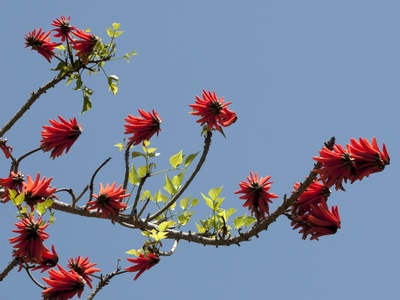
Common Coral Tree
A truly spectacular deciduous tree that produces brilliant scarlet-red flowers on bare branches. The striking blooms are full of nectar, attracting a wide variety of birds, making it a hub of activity.

Tumbleweed
A fascinating bulbous plant with a fan of grey-green, wavy leaves. Before the leaves appear, it sends up a thick stem topped with a large, spherical head of sweet-scented, pink, star-like flowers.
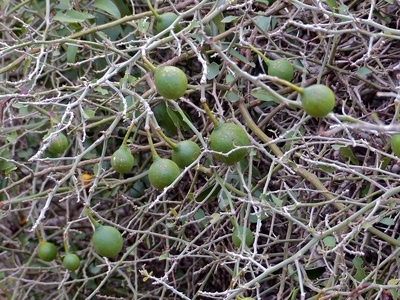
Woolly Caper-bush
A robust, thorny climber or scrambling shrub. It produces beautiful, fragrant flowers with four white to pinkish petals and a prominent puff of long, pinkish-purple stamens that open at dusk.
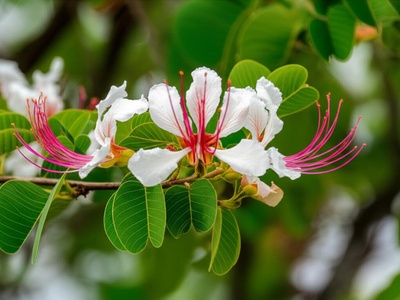
Kalahari Bauhinia
A multi-stemmed shrub or small tree with distinctive, two-lobed leaves resembling a butterfly’s wings. It produces large, fragrant, and crinkly white flowers with long, elegant, reddish stamens.
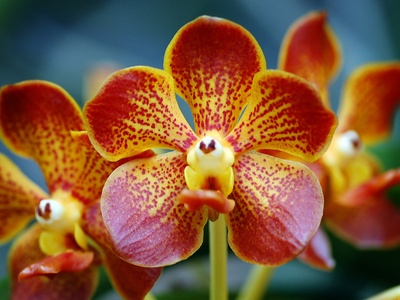
Leopard Orchid
Botswana’s most dramatic and largest orchid species. It forms huge clumps on host trees and produces long, arching sprays of waxy, yellow-green flowers that are heavily blotched with maroon or chocolate-brown spots.
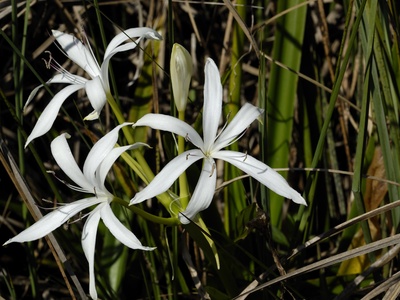
Swamp Crinum
A very large bulbous plant that often flowers en masse after heavy rains. It produces an umbel of huge, fragrant, trumpet-shaped white flowers, each with a distinctive deep pink stripe down the center of the petals.
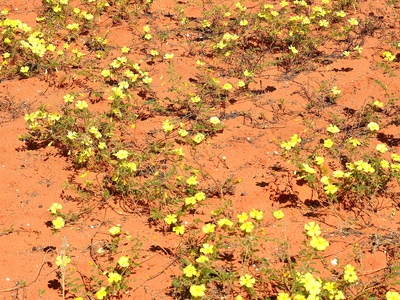
Devil’s Thorn
A common, flat-growing annual weed that thrives in the dry season. It produces cheerful, bright yellow, five-petaled flowers that open in the sun, followed by woody fruits armed with sharp, vicious spines.
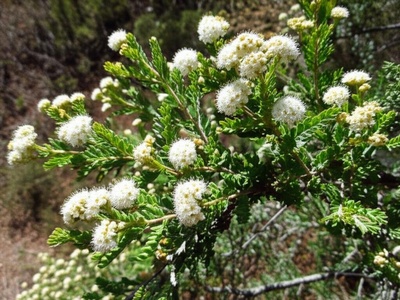
Fever Tea
A strongly lemon-scented, multi-stemmed shrub. It has rough leaves and produces small, dense, rounded heads of tiny, creamy-white flowers. The leaves are widely used to make a refreshing and medicinal tea.
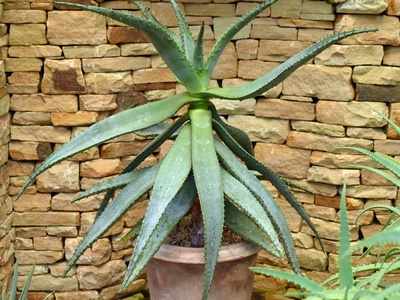
Bitter Aloe
A large, imposing, single-stemmed aloe, often with old, dried leaves forming a “skirt.” It produces a massive, branched flower spike with dozens of racemes of tubular, orange-red flowers, creating a magnificent winter display.
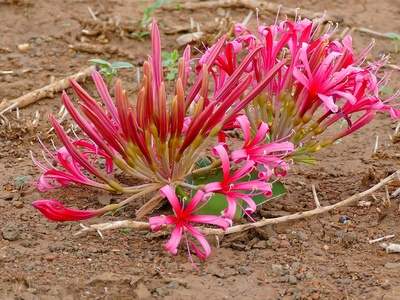
Ground-lily
A bulbous plant that lies dormant until triggered by rain. It produces a large, ground-level cluster of fragrant, strap-like, bright pink to deep rose-colored flowers before the leaves appear.
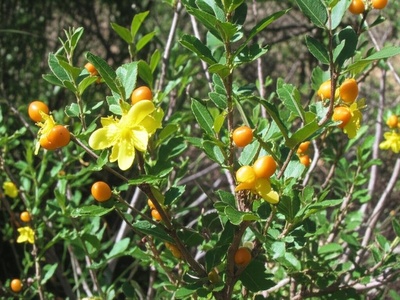
Sandpaper Raisin
A hardy, multi-stemmed shrub with rough, sandpaper-like leaves. It produces small, delicate, star-like yellow flowers, followed by small, edible, brownish-orange fruits with a sweet, raisin-like taste.
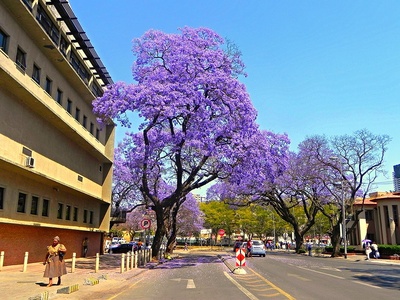
Pink Jacaranda
A small, deciduous tree with a pale, flaking bark. When leafless, it covers itself in trusses of beautiful, fragrant, pink to mauve, foxglove-like flowers, providing a soft splash of color to the dry bush.

Hoodia
A spiny, leafless, cactus-like succulent known for its appetite-suppressant properties. It produces large, fleshy, saucer-shaped flowers that are pale purple or brownish and emit a foul smell to attract flies for pollination.
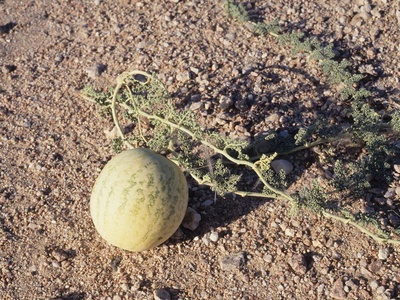
Tsamma Melon
The wild ancestor of the domesticated watermelon. This creeping vine is a vital source of water in the Kalahari. It has large, deeply lobed leaves and produces solitary, yellow, five-petaled flowers.
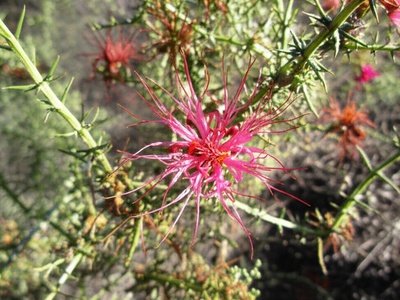
Large-flowered Worm-bush
A peculiar, leafless, and tangled green-stemmed shrub. It stands out when it produces unusual, spidery flowers with four narrow, reddish petals and a prominent cluster of long, purplish stamens.
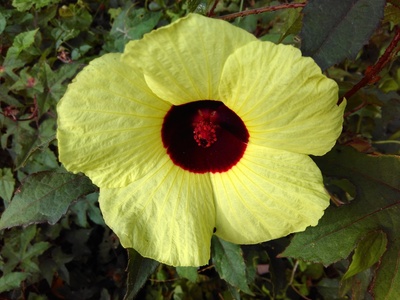
Wild Hibiscus
A tall, erect herb with variable, often lobed leaves. It produces large, showy, and elegant flowers, typically pale yellow or cream with a deep maroon or purple center, lasting only a single day.
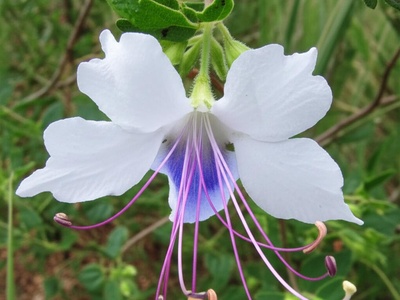
Okavango Cat’s Whiskers
A scrambling shrub armed with hooked spines. It has unique and intricate white flowers with four ruffled upper petals and a lower blue or purple lip, and extremely long, curved, purple stamens.
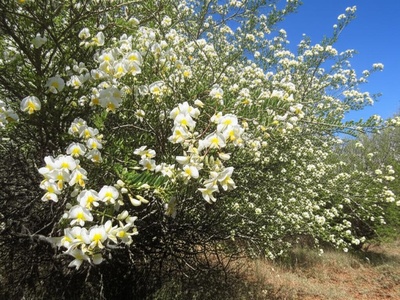
Sand Camwood
A multi-stemmed shrub or small tree that often forms dense thickets. It becomes covered in masses of fragrant, white, pea-like flowers with a yellow splash on the upper petal, creating a lovely display.
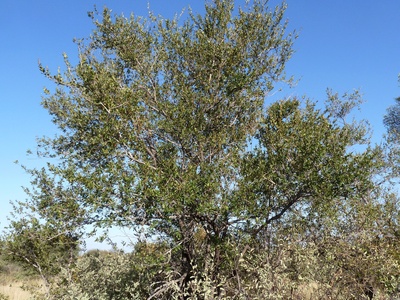
Russet Bushwillow
A common, multi-stemmed shrub or small tree with a neat, rounded crown. It is one of the first to flower in spring, producing dense, axillary spikes of small, fragrant, cream or yellowish flowers.

Common Star-chestnut
A small, stout, succulent-stemmed tree with peeling, papery bark. Before the large, heart-shaped leaves appear, it produces attractive clusters of small, cup-shaped, yellow flowers that are striped with maroon inside.
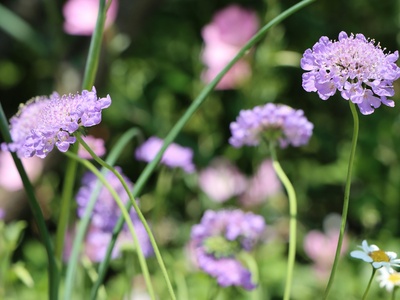
Wild Scabious
A delicate perennial herb with variable, lobed basal leaves. It produces long-stemmed, pincushion-like flowerheads with small florets, typically in shades of pale blue, lilac, or white, attracting butterflies.
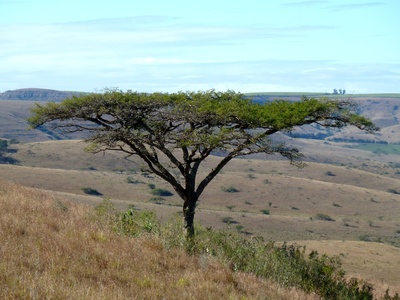
Paperbark Thorn
A classic, flat-topped acacia tree with a distinctive yellowish, papery, peeling bark. In spring, it is covered in fragrant, creamy-white, fluffy, ball-shaped flowers, making it a beautiful sight.
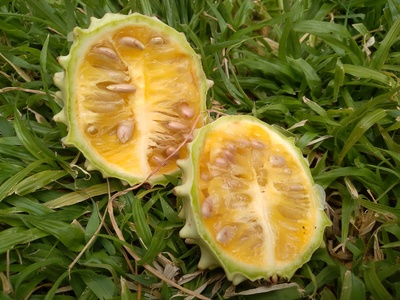
Gemsbok Cucumber
A trailing perennial herb that grows from a large underground tuber. It has deeply lobed, rough leaves, produces yellow, trumpet-shaped flowers, and is well-known for its spiny, pale green, edible fruit.
